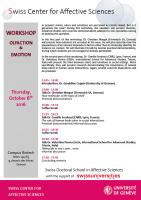
Workshop “Olfaction & Emotion”
06.10.2016 13:45 – 17:45
In people’s minds, odors and emotions are perceived as closely linked. But is it genuinely the case? During this workshop, the speakers will present theories, empirical studies and concrete demonstrations adapted to non-specialists aiming at tackling this question.
In the first part of this workshop, Dr. Christian Margot (Firmenich SA, Geneva) will present how odorants are encoded in the nose. He will also describe how the pleasantness of an odorant depends on factors other than its molecular identity, for instance on context. He will illustrate his talk by several practical demonstrations, during which students are encouraged to actively participate.
In the second part of this workshop, Dr. Camille Ferdenzi (CNRS, Lyon, France) and Dr. Valentina Parma (SSISA, International School for Advanced Studies, Trieste, Italy) will present the links between odors and emotions in social settings. More specifically, they will present research demonstrating the importance of natural body odors in human social interactions. Again, several concrete illustrations will be provided.
13:45 - 14:00
Introduction: Dr. Géraldine Coppin (University of Geneva)
14:00 - 15:00
Talk Dr. Christian Margot (Firmenich SA, Geneva)
How molecular is the logic of smell
Our sense of smell monitors the molecules present in the immediate environment or the oral cavity. Carried by the air entering our nose during respiration, these molecules interact with specialized receptors localized within the cell membranes of olfactory receptor neurons. The signal generated by these peripheral neurons will eventually be interpreted by the brain as an odor or an aroma. Twenty-five years after the discovery of the vertebrate olfactory receptors, a consensus emerges about the encoding of odorants in the nose, involving a so-called combinatorial encoding: every olfactory receptor recognizes a range of molecules, and conversely, every odorant appears to activate a specific subset of the several hundreds of receptors expressed in most vertebrate noses. This has been named the molecular logic of smell. However, this model alone cannot account for the entire olfactory encoding and the corresponding perception. Especially, molecules with very different structures and functionalities can elicit the same odor. Further, the blend of different odorants can elicit a new odor in which none of the components can be recognized. Still further, the perceived quality of an odorant can vary depending on the taste context; and finally, we wish to mention that the intrinsic pleasantness of an odorant does not depend on its molecular identity, based on different examples and the properties of odorant mixtures containing unpleasant components.
15:00 - 15:15
Coffee break
15:15 - 16:15
Talk Dr. Camille Ferdenzi (CNRS, Lyon, France)
The role of human body odors in social interactions
Social communication is one of the three major functions of olfaction (the other two being danger detection and food intake). However, many aspects of this function remain a mystery in humans. The odor emitted by our body is extremely important in human interpersonal relationships. It shows through the amount of energy we spend every day to control it, but also through the serious consequences of olfactory loss on the quality of interactions with our beloved ones. This talk presents several studies aiming at better understanding the importance of natural body odors in human social interactions, mostly in a mate choice context.
16:15 - 16:30
Coffee break
16:30 - 17:30
Talk Dr. Valentina Parma (SISSA, International School for Advanced Studies, Trieste, Italy)
Taking life in one’s own… nose
With the transmission of stable features of an individual (e.g., gender assignment) as well as transitory states (e.g., emotions), human axillary secretions transmit safety and warning messages. In line with research conducted in other sensory modalities such as vision, I will show how safety signals promote social cohesion between kin and mates and how warning signals of unknown and sick individuals enjoy prioritized, unconscious processing. Furthermore, I will discuss how the available behavioral, psychophysiological and neuroimaging findings contribute to the analysis of the mechanisms at the basis of social chemosignal communication.
17:30 - 17:45
Concluding remarks
Lieu
Bâtiment: Campus Biotech
Room 144.165
Organisé par
Centre interfacultaire en sciences affectives (CISA)entrée libre
Classement
Catégorie: Séminaire
Plus d'infos
Contact: missing email
Fichiers joints
| Workshop Olfaction & Emotion.pdf | 267.7 Kb |

 haut
haut